Simon Guerrier's Blog, page 30
July 10, 2022
Once Upon a Galaxy: The Making of the Empire Strikes Back, by Alan Arnold
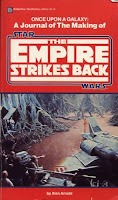 This remarkable book has long been out of print and copies sell for silly money, but it's well were tracking down. Alan Arnold was the publicist on The Empire Strikes Back, his job to big up the first sequel to Star Wars, on which so much was riding. Arnold had worked on some 40 films before this assignment, but admits to "misgivings" about whether "a writer with a detached and ambivalent outlook" was really the right person for this particular job. He describes the first Star Wars film as "a 'light show', an audacious pantomime" (p. vii), which is not exactly a compliment.
This remarkable book has long been out of print and copies sell for silly money, but it's well were tracking down. Alan Arnold was the publicist on The Empire Strikes Back, his job to big up the first sequel to Star Wars, on which so much was riding. Arnold had worked on some 40 films before this assignment, but admits to "misgivings" about whether "a writer with a detached and ambivalent outlook" was really the right person for this particular job. He describes the first Star Wars film as "a 'light show', an audacious pantomime" (p. vii), which is not exactly a compliment. His detachment is quickly evident. The diary starts on 3 March 1979 with the crew struggling through a blizzard to reach Finze in Norway for the start of location shooting. Arnold mutters that in these treacherous conditions no one helped him unload the suitcases from the train, singling out Mark Hamill (Luke Skywalker in the film) in particular.
"But [I] told myself without total conviction that Mark was probably more concerned about his [pregnant] wife." (p. 5)
Yes, that may have been on his mind.
Arnold details the problems faced by the production and the ingenious solutions: shooting key scenes in the snow just outside their hotel; getting Harrison Ford (Han Solo) to join them last-minute as the schedule is changed; the logistical response to mounting costs and delays.
There's plenty of great detail, not least because Arnold had access to the lead actors and a wide range of those on the crew. There's a good interview with the notoriously reticent Harrison Ford on page 24, though the actor later brushes off a second attempt. I didn't know that the film's Snowspeeders were designed by Ogle Design Ltd, "a company better known for its Reliant sports car (p. 39), and I like production designer Norman Reynolds' description of these new creations as flying "close to the surface like an airborne tank." (p. 43).
It's interesting to see how practicalities shaped things, and how very different Star Wars might have been: the carbon-freezing of Han Solo, described at times here as his "execution", covered the fact that Ford might not have featured in the third film. On 15 May 1979, well into production, producers George Lucas and Gary Kurtz take Sir Alec Guinness out to lunch to discuss whether he will participate in the film (p. 85), something still apparently in doubt until 5 September when he turns up for his single day (p. 240). At one point Lucas suggests the part might have been recast.
Arnold is a little pretentious at times, sharing a history of the medieval Mummers (p. 60), or likening new character Boba Fett to Shakespeare's Richard II (p. 67). But he's also got a good eye for the telling, incongruous moments.
"Of England it's alleged that everything there stops for tea, but this is not true in the film business. It is taken on the run, without interruption to the work continuing on the floor. Morning and afternoon, trolleys bearing urns of tea and coffee are wheeled onto the soundstages by ladies whom you suspect have spent the interim studying their horoscopes. They are actually immune to surprise, even when the lineup for tea includes, as it did today on the ice-cavern set [4 April], a platoon of snowtroopers in white armoured suits, a robot, Darth Vader, and the Wampa Ice Creature. The imperturbable tea ladies served them all with their characteristic cool, as calm as Everest explorers confronted by an abominable snowman. They know that anyone who enjoys a cup of tea can't be all that abominable." (p. 61)
There's an especially extraordinary sequence, pp. 128-147, in which Arnold has director Irvin Kershner miked up while shooting the pivotal scene of Han Solo's "execution" in the carbon-freezing chamber. He and Ford puzzle over dialogue and motivation, honing the words on the page into something really powerful. But Carrie Fisher (Princess Leia) then objects to getting these changes last minute, and from Ford rather than the director. She lashes out - literally slapping Billy Dee Williams (Lando Calrissian). And just as it's all kicking off, David Prowse (Darth Vader) tries to interest the director in his new book on keeping fit!
Fisher surely didn't approve the use of this in the book, or producer Gary Kurtz's comments that she "doesn't always look after herself as she should [and] doesn't pay sufficient attention to proper eating habits" (p. 123). Yet Arnold is also protective of the young actress, such as when she's subjected to a journalist who had got onto the set under false pretences - an experience Fisher describes as akin to a "rape" (p. 81). He's also sensitive to her skills as an actress, inspired by close study of old, silent films that focus on the close-up.
Arnold also reports a spat between Hamill and the director, soon after Hamill's baby son is born. At the time, the fractiousness is put down to Hamill having damaged his thumb (p. 150) which might mean the lightsaber battle that he has trained for will now be performed by a double. The sense is that neither Hamill nor Fisher had any say over this nakedly honest stuff being put in the book; the publicist who ought to have been protecting their interests was the one who wrote it. But later, Hamill at least gets to put this "terribly childish" disagreement in context.
"Our only real flare-up was on the carbon-freezing chamber set. Tempers were on edge anyway because it was like working in a sauna ... "Everybody felt guilty seconds later" (p. 213)
We finish with the film being edited, and Arnold getting lost on his way to the home of John Williams, who is busy composing the score. The book was published in August 1980 to coincide with the release of the film - so there was no way of knowing if all this work was going to pay off. Like the film itself, we leave on a cliffhanger.
Arnold concludes in philosophical mood about the creative arts in general, but more striking is what follows his words: credits listing all the many people involved in making the film.
See also:
The Princess Diarest, by Carrie FisherEmpire Building - The Remarkable Real Life Story of Star Wars, by Garry JenkinsStar Wars Identities exhibitionOn the future of Star Wars, an article I wrote in 1999July 3, 2022
One Day in the Life of Ivan Denisovich, by Alexander Solzhenitsyn
"In all his time in camps and prisons, Ivan Denisovich had lost the habit of concerning himself about the next day, or the next year, or about feeding his family. The authorities did all his thinking for him, and, somehow, it was easier like that." (p. 40)
This extraordinary book, detailing the waking hours on a bitterly cold day in a Russian work camp sometime in the early 1950s, is based on the real-life experience of Alexander Solzhenitsyn, who was released from such labour in 1957.
First published in the USSR in 1962, my 1970 translation by Gillon Aitken is at least the third version in English. I can see why this book so haunted a generation. It seems to have influenced subsequent memoirs - of Soviet gulags, of the concentration camps in the war, of systems of oppression more generally.
In the USSR, the book and its implicit criticism of the regime overseen by Stalin was initially welcomed - perhaps emblematic of the new, more liberated era of Khrushchev. When Khrushchev was himself stripped of power in 1964, Solzhenitsyn fell out of favour. His books weren't exactly banned in the USSR, but life was made increasingly difficult.
When, in 1969, Solzhenitsyn was chucked out of the Union of Writers in Russia, various bodies around the world staged protests of one kind or another. Most notably, the author was awarded the 1970 Nobel Prize for Literature. In July 1969, the Writers' Guild of Great Britain sent two delegates to the International Writers Guild conference being held in Moscow with the specific brief of making some protest about the treatment of Solzhenitsyn. One of those delegates was David Whitaker, and I've been reading his accounts of what happened there - and the fall-out from it. More of that anon.
The book is full of extraordinary moments: the men discussing the merits and techniques of Eisenstein's cinema as they get on with their weary toil in the snow; the man who is in prison because of the heinous crime of having received a note of gratitude from an English admiral after service in the war; the way a prisoner receiving a parcel of food from their family finds themselves in debt to everyone else...
In observing these details within the drudgery, Solzhenitsyn shows us the mechanics of the operation, the way the oppression works. The infighting of prisoners compels them to work, to play an active role in the system imprisoning them.
"Who is the prisoner's worst enemy? Another prisoner. If only the prisoners didn't fight with each other, then..." (p. 114)
And while it's about the system, it's also about how an individual might survive in such conditions. Ivan Denisovich Shukhov hordes a crust of bread, does favours to earn himself an extra bit of thin soup, and squirrels away a broken bit of hacksaw blade with which he can later fashion a knife that will be useful for mending clothes. Only then the prisoners get searched and this small theft risks putting him,
"in the cells on 300 grams of bread a day and hot food once every three days. He imagined at that moment how enfeebled and hungry he would become and how difficult it would be to recover his present condition of being neither starved nor properly fed." (p. 117)
All that effort to keep going could be undone in an instant. And we're left with the horrible fact that this is just one day in 3,653 of Shukov's 10-year sentence. The last line of the book adds one further systematic cruelty.
"The three extra days were because of the leap years..." (p. 157)
June 29, 2022
Curse of the Chosen, by Alexis Deacon
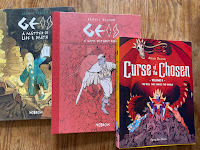 A little over four years ago, I posted about A Game Without Rules, the second volume in the Geis trilogy of graphic novels written and illustrated by Alexis Deacon. I said then that I eagerly awaited the third and final volume - but didn't anticipate having to wait quite so long.
A little over four years ago, I posted about A Game Without Rules, the second volume in the Geis trilogy of graphic novels written and illustrated by Alexis Deacon. I said then that I eagerly awaited the third and final volume - but didn't anticipate having to wait quite so long.Since then, the first two instalments of Geis have been issued in a single tome, now called Curse of the Chosen. And now, at last, comes what's called Curse of the Chosen Volume II: The Will That Shapes the World but I think of as Geis III. It's a slightly smaller size than Geis and in paperback, but the moment I opened the cover I was back in that extraordinary, strange world as if I'd never been away.
As before, we're in a weird fantasy castle where a deadly contest is taking place. Originally, 50 competitors vied with one another to become the new head of state, but that's been whittled down to a handful - and one of them is, we now realise, not at all what she seems. There's something here of Squid Game, only with magic and talking animals, perhaps mixed up with the Earthsea of Ursula le Guin. Plus the artwork is beautiful, even as the horror mounts. More than once I gasped.
One of the things that makes this story so effective, I think, is how much the odds are stacked against the kindly, heroic characters - a young girl, a small man and a cat. That strikes a chord with something TV mogul Sydney Newman says in his memoirs, having watched different audiences in front of the same movies.
“A revelation to me was discovering how to get a sure response from an audience: compassion.” (p. 99)
That's what this: extraordinary, imaginative and compassionate fantasy.
June 28, 2022
Head of Drama, by Sydney Newman (with Graeme Burk)
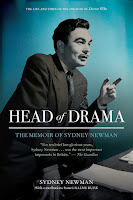 Written in 1987 and published in 2017, this memoir is subtitled "The life and times of the creator of Doctor Who" - a claim Newman was, at the time he wrote the book, battling the BBC to acknowledge. My mate Graeme Burk, who edited the book and wrote the accompanying essay, explains why this credit meant so much to him then, when so much of his extraordinary work for television had been rather forgotten.
Written in 1987 and published in 2017, this memoir is subtitled "The life and times of the creator of Doctor Who" - a claim Newman was, at the time he wrote the book, battling the BBC to acknowledge. My mate Graeme Burk, who edited the book and wrote the accompanying essay, explains why this credit meant so much to him then, when so much of his extraordinary work for television had been rather forgotten. Burk had access to the Newman archive, and I'm beside myself with envy at some of the material he's had at his fingertips. The Ur-text of all Doctor Who archaeology is the 1972 book The Making of Doctor Who by Malcolm Hulke and Terrance Dicks. According to Burk, Hulke wrote to Newman on 6 August 1971 asking him for memories of how the programme came about. On 28 September, Newman replied:
“I don't think I'm immodest in saying that it was entirely my concept, although inevitably many changes were brought about by Verity Lambert, who was its first producer. She would be the very best source of information, better than say, David Whitaker or even Donald Wilson.” (pp. 448-449)
However, by the time Newman sent this, Hulke had spoken to Donald Wilson (on 8 September) who told him what's generally considered the fact: that Doctor Who was created by Newman and Wilson.
“It was just Sydney and I together, chatting. At an early stage we discussed it with other people, but in fact the title, as I remember, I invented…” (p. 450)
Burk digs into this, citing some counterclaims, analysing the surviving paperwork from those early days and addressing the issue that some key papers appear to be missing from the archive. I've some more to add to this in my forthcoming book on story editor David Whitaker.
Anyway, Doctor Who is just one of the many, many shows Newman worked on. Head of Drama conveys the extraordinary range and impact of his work, from documentary films to opera and everything in between. There's what he learned from double-checking ticket sales in a cinema and watching the reactions of different audiences to the same film, and what working in newsreel and sport taught him about staging drama. He delights in telling us when he got something wrong - he was against employing chat-show host Ed Sullivan, tried to cancel the Daleks and resisted Donald Wilson in commissioning The Forsyte Saga.
But time and again, Newman's instincts for what would be popular and connect with a broad audience were dead right. Just one example of his many, many insights here:
“I laid down some simple notions [while at ABC]. Some people become physically ill when they see blood, and only a fool wants an audience to puke. Ergo, show blood with care. Some in the audience are daffy with hate, so don’t show them how to make a bomb. Viewers will identify with the innocent character, so being bound and helpless and tortured becomes powerfully disturbing, and that kind of reaction is a turn off. And finally, avoid common, easily available weapons such as a kitchen knife, so as not to provoke a viewer who may be feeling momentary murderous rage to act upon it in the moment.” (p. 304)
Newman gives full credit to the many writers and producers and talented people he worked with, but he's an amazing, funny and honest storyteller. There are some amazing stories here. Just before the Second World War, he was offered a job with Disney but had to head to back to Canada to sort out a visa. On the way, a fellow passenger seems to have reported him - as being an illegal immigrant from Mexico! The result was jail and some very hairy moments, but Newman tells it all with compassion and a wry smile, tying it all into a broader theme of having always been an outsider, an exile. And then he concludes that without this sorry business and the problems of a visa, had he been able to take that Disney job, he'd have ended up drafted into the US army and killed at Iwo Jima.
He shrugs that all off and is then onto the next drama.
June 27, 2022
Still Life, by Sarah Winman
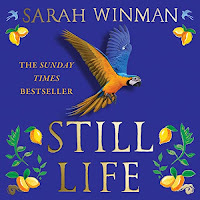 Ulysses Temper is a British soldier in Italy during the Second World War. There he befriends art historian Evelyn Skinner, and helps her rescue paintings from the conflict. We follow Ulysses home to austere, post-war London, to discover that his wife Peg has had a baby with someone else and now wants to divorce him. Ulysses bonds with his ex-wife's daughter in a way Peg never has, and when he returns to Italy the girl goes with him. Around them flit and linger other lives, a cast of misfits variously longing and grieving and muddling things out. Along the way there are musings on fate and art and love, and a sense of the muddle slowly being worked out...
Ulysses Temper is a British soldier in Italy during the Second World War. There he befriends art historian Evelyn Skinner, and helps her rescue paintings from the conflict. We follow Ulysses home to austere, post-war London, to discover that his wife Peg has had a baby with someone else and now wants to divorce him. Ulysses bonds with his ex-wife's daughter in a way Peg never has, and when he returns to Italy the girl goes with him. Around them flit and linger other lives, a cast of misfits variously longing and grieving and muddling things out. Along the way there are musings on fate and art and love, and a sense of the muddle slowly being worked out...I loved this strange, big-hearted ramble of a book, its vivid characters, its love of life and the echoing horror of loss. The death of one kindly character late on hits extremely hard. How fitting, too, to fall into a novel all about passion for the art of Urbino and Florence as I drove to the memorial for my old A-level Art History teacher, who on Friday afternoons more than 30 years ago shared his joy at Giotto, Uccello and Massaccio.
June 24, 2022
On the Sixth Doctor Who
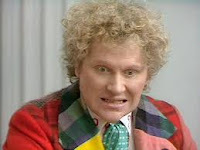 I've been enjoying the new Blu-ray release of the 1985 series of Doctor Who, adventures that made such an impression on me as kid. And that's prompted me look out the introduction I wrote for The Court Jester, the now out-of-print book version of the blog in which Sue and Neil Perryman watched all the Sixth Doctor's episodes...
I've been enjoying the new Blu-ray release of the 1985 series of Doctor Who, adventures that made such an impression on me as kid. And that's prompted me look out the introduction I wrote for The Court Jester, the now out-of-print book version of the blog in which Sue and Neil Perryman watched all the Sixth Doctor's episodes...Foreword by Simon Guerrier
Thursday, 15 March 1984
My first thought is “good.” Janet Ellis on Blue Peter has just introduced Colin Baker as the new Doctor Who. My family don't buy newspapers and no one's said anything at school, so I'm pretty sure this is the first time I learn that Peter Davison is leaving. I've still not forgiven him for replacing Tom Baker.
Friday, 16 March 1984
The poisonous bat poo the Doctor touched three weeks ago finally kills him. My elder brother and sister join me and my younger brother to watch part four of The Caves of Androzani. I think it's the first time they – now serious, grown-up teenagers – have watched since The Five Doctors. They tell us, as always, that Doctor Who used to be much scarier than this sorry nonsense. I'm certain they're right and can't wait for this story to finish so we can get on to the new Doctor as he's sure to make everything better. I mean, a boy at school insists Colin is Tom Baker's brother.
Thursday. 22 March 1984
The Sixth Doctor era proper begins with part one of The Twin Dilemma. It's a very intelligent story – it must be, as I'm not always sure what's happening or what the Doctor is talking about. It's not exactly a scary story, but the Doctor attacking poor Peri and then later hiding behind her for safety means we're not sure what to make of him. “Look how clever they're being,” I'd tell my siblings if they asked my opinion. But they don't.
Saturday, 5 January 1985
A boring shopping trip to Southampton turns out to be a brilliant trick by my parents, and me and my younger brother are really off to see the stars of Doctor Who in the pantomime Cinderella. Colin Baker runs on to the stage pushing a shopping trolley with a Doctor Who number plate on it, to the most deafening cheer from the audience. People really love his Doctor! My parents' ingenious plan is to see the matinee performance so that we can be home in time for the first episode of the new series of Doctor Who on TV. But we get caught in traffic because of a football match, so I miss Part One of Attack of the Cybermen. There is much weeping.
Saturday, 12 January 1985
I sit entirely baffled by what's happening in Part Two of Attack of the Cybermen, certain it would all make sense if only I'd seen part one. (I don't get to see part one until 1993, and am still not entirely sure what's happening.)
Saturday, 26 January 1985
Part Two of Vengeance on Varos gives me nightmares. I'm really creeped out by the monstrous Sil and the story is full of horrid details, but what really gets me is when the Doctor rescues Peri from being turned into a bird. She looks human but the Doctor has to keep repeating her name to re-imprint her identity. The thought I can't shake is that she might be permanently changed, a monster on the inside...
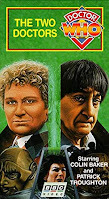 Saturday, 16 February 1985
Saturday, 16 February 1985ITV shows The A-Team at the same time as Doctor Who. After some discussion with my brother and a friend who doesn't have a telly so is often round to watch ours, we agree to video part one of The Two Doctors and watch The A-Team live. I distinctly remember the logic involved: Doctor Who is the one we'll want to watch more than once. It's not as slick, the fights aren't as good, and it's not so loved by our schoolmates but there's more to each episode. Good thinking, eight year-old me.
Saturday, 9 March 1985
I completely love Part One of Timelash. At school the next week, I insist to a friend that of course bumbling Herbert will be the new companion.
Saturday, 23 March 1985
The scariest moment ever seen in Doctor Who – at least, I think so now. Natasha finds her father, who's being turned into a Dalek and begs her to shoot him. The writing, performance, effects and music are all perfectly horrible. These days, I show a clip of this in talks I give on Doctor Who – just to see the audience squirm. After one talk, the parents of a keen young fan make a point of apologising to me for having told their daughter that Doctor Who wasn't very good in the 1980s.
Saturday, 30 March 1985
We're still watching The A-Team live and videoing Doctor Who, each week recording over the previous episode on the one tape we're allowed to use. Part Two of Revelation of the Daleks is the final episode of this year's series so doesn't get taped over the following week. My younger brother's interest in Doctor Who is waning but my three year-old brother Tom watches that tape again and again for weeks. A moment in that episode haunts me each time I see it, even now. As the Doctor runs down a corridor on his way to battle the Daleks, he thinks he hears Peri being exterminated. There's a moment of horror, of pain, on his face, and then he rallies himself and runs on. No words, just how Colin Baker plays it, so perfectly the Doctor.
Sometime in April 1985
It's all my pocket money, but I spend the vast sum of £1 on the 100th issue of The Doctor Who Magazine. It's a massive disappointment, lacking the weird wonder and excitement the TV series kindles in me. Instead, the magazine is full of lengthy, dense articles about the minutiae of the programme's past. I cannot fathom why anyone would find this of interest. I don't buy DWM again for five years.
Summer 1985, Winter 1985, Spring 1986
Then there's a gap. It came as a complete surprise to me, many years later, to learn that Doctor Who had been on hiatus for 18 months, that there'd been criticism of the violence in the programme, that it was even discussed on the news. At the time, I don't spare the absence a thought – of course Doctor Who will be on again at some point. I don't know there's been a new Doctor Who story, Slipback, on the radio until its released on cassette years later. But I've begun producing my own Doctor Who stories in which my brothers are horribly killed by various monsters.
Tuesday, 24 June 1986
I'm pretty sure I get the novelisation of Timelash for my 10th birthday. The TV version is my favourite of the Sixth Doctor's stories to date, and I read the book over and over. One big appeal is the references to the Third Doctor who, thanks to the Target books I've been picking up second hand and from the library, is my all-time favourite Doctor. But the story also really grabs me, and I spend the summer leaping over the garden sprinkler to be banished back in time.
Saturday, 6 September 1986
Doctor Who returns in a story called The Trial of a Time Lord. I'm especially pleased because we had a school trip to the “ancient” farm at Butser Hill used as a location. But otherwise the first four episodes seem to leave little impression. My memories of the Doctor Who I watched in the 1980s are usually vivid, but when I watch Part One of Trial again on video years later, I'm amazed to discover I can't recall any of what happens next. Perhaps Doctor Who wasn't affecting me as deeply as it once did – no longer the terrifying experience I couldn't bear to miss. Or perhaps these first episodes of the story were completely blotted out of my memory by the ones that followed.
Saturday, 4 October 1986
I am properly terrified by the return of Sil from last year's Vengeance on Varos. This section of the Doctor's trial is the last time Doctor Who ever really scares me. Part of the reason I've stuck with the series all these years on is the morbid hope it will scare me like that again.
Saturday, 1 November 1986
Bonnie Langford makes her début as Mel. My wife says this is when she made the decision to stop watching Doctor Who, which means she still doesn't know the outcome of the Doctor's trial. (Don't tell her.)
Saturday, 6 December 1986
The final episode of The Trial of a Time Lord – and of the year's Doctor Who.
Saturday, 13 December 1986
I sit through hours of programmes on BBC One before the dismal truth sets in that one 14-episode story is all we're getting.
Thursday, 18 December 1986
Colin Baker, in his Doctor Who costume but not quite in character, appears as a team captain on the Tomorrow's World Christmas special. I take this as irrefutable evidence that he's busy filming the new series which must surely start on TV early in the new year. I can't wait!
Monday, 2 March 1987
Janet Ellis on Blue Peter has news about the next series of Doctor Who – and chats to her mate Sylvester McCoy who is going to be the new Doctor. I am flabbergasted. Sylvester McCoy is from children's programmes!
Monday, 7 September 1987
The unceremonious end of the Sixth Doctor, who dies by falling over in the TARDIS before the opening titles of Time and the Rani Part One. I sharply recall my embarrassment at how silly the rest of the episode is, sure Doctor Who has lost its way. I've also just started secondary school, and realise that Doctor Who is no longer a programme to be fiercely discussed in the playground over the next week. I mention this to a friend who's gone to a different secondary school and he's astonished. “Are you still watching Doctor Who?”
But I am. It becomes a guilty pleasure. I know – because people keep telling me – that Doctor Who is not as good as it used to be. It was once something everybody watched but now I know hardly anyone who'll admit to having seen the latest episodes.
Today, I know there were problems behind the scenes of the programme: disagreements between those making it, a lack of interest high up at the BBC, a dozen other things. I avidly read – and contribute to – articles in DWM poring over exactly what was to blame. But I also know it was as much to do with the age me and my friends were at the time, and the other pressures and interests affecting us. They simply outgrew this children's programme while I couldn't let it go.
The upshot is that the Sixth Doctor's era marks a fundamental change in my relationship to Doctor Who. Whatever anyone else thinks of this period of the show – and Neil and Sue are about to share their own strong opinions on it – it holds a special place in my heart.
Because at the start of Colin Baker's time as the Doctor, the programme was something I shared with pretty much everyone I knew. By the end, it was mine.
Simon Guerrier
24 April 2017
June 23, 2022
Doctor Who Magazine #579
 There's a lot going on in the world(s) of Doctor Who at the minute. Production is under way on next year's 60th anniversary episode(s?), with David Tennant and other stars spotted out filming. The 1985 series of Doctor Who has just been released on Blu-ray (including the extras me and brother Tom made for Vengeance on Varos). And the 10-part podcast drama Doctor Who Redacted has just finished its run. All these things are covered in the new issue of Doctor Who Magazine.
There's a lot going on in the world(s) of Doctor Who at the minute. Production is under way on next year's 60th anniversary episode(s?), with David Tennant and other stars spotted out filming. The 1985 series of Doctor Who has just been released on Blu-ray (including the extras me and brother Tom made for Vengeance on Varos). And the 10-part podcast drama Doctor Who Redacted has just finished its run. All these things are covered in the new issue of Doctor Who Magazine.As well as all this, there's a new "Sufficient Data" infographic from me and Ben Morris, this time on the ages and ages of the actors playing Doctor Who.
June 22, 2022
CERN: Science Fiction and the Future of Detection and Imaging
I've had the most amazing few days in Geneva as a guest of Ideas Square at CERN. It's the first time I've been out of the UK in three years, and I was jangly with nerves for a good week before setting off; I'll be jangly with excitement about it all for some time to come.
During lockdown, my friend Dr Una McCormack roped me into some online sessions where sci-fi writers (hello!) were brought in to help / hinder the work being done by students from round the world in attempting to imagine the future impact of technology. This week, a bunch of us assembled in person, got a tour of the Large Hadron Collider and other CERN bits and bobs, and had lots of really interesting chat about, well, everything really. There was high-end physics, and high-end gossip, and high-end physics gossip.
I've returned home with pages and pages of notes in my notebook - bits of new ideas, lists of things to read or look into, random bits of detail. For example, one thing that boggled my brain was that work on constructing the CMS detector (one of a number of detection instruments located round the Large Hadron Collider) was delayed by the discover of Roman ruins on site which then had to be painstakingly excavated. I'm taken by the Nigel Kneale-ish thought of ancient ghosts being picked up by the sensitive detectors...
Then there was the fact that when building this underground facility the team had to dig through a subterranean river. To do so, they dug down to the level of the river, then froze it and dug through the ice, constructing a concrete-lined shaft through the middle before letting the ice thaw. Ingenious!
And how extraordinary, how liberating, to discover that in visiting the CMS we had crossed the border into France without a moment's thought let alone all that mucky business with passports. Coming home, there weren't enough ground crew to let us off the plane so we sat stewing for 45 minutes. There must be a better way of doing things, I thought. Which was exactly the sort of thing these few days have been about.
Here are a few pictures...
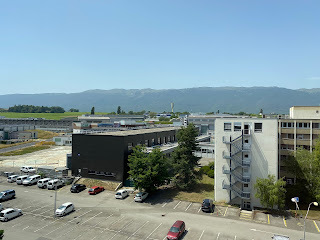 View of mountains from CERN hostel
View of mountains from CERN hostel Geneva tram, for my father-in-law
Geneva tram, for my father-in-law More mountains, plus v hot writer
More mountains, plus v hot writer Tour of the CMS facility;
Tour of the CMS facility; photo of detector like a gothic rose window
 Going underground
Going underground Warning signs to give one pause
Warning signs to give one pause The LHC creates a magnetic field;
The LHC creates a magnetic field; look at its effect on these paperclips!
 Doctor U and her plucky assistant
Doctor U and her plucky assistant New hat / cool museum
New hat / cool museum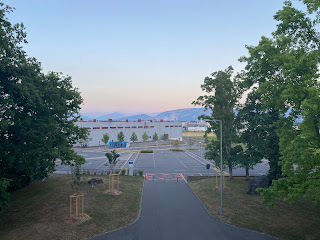 Hot, hot evening, and yet snow on the mountains
Hot, hot evening, and yet snow on the mountains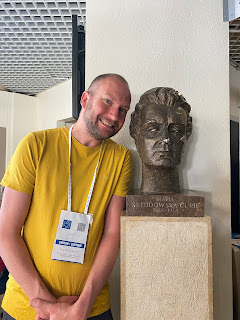 Marie Curie clearly delighted to meet me
Marie Curie clearly delighted to meet me Very heavy lead,
Very heavy lead, so dense it would shatter to dust if dropped
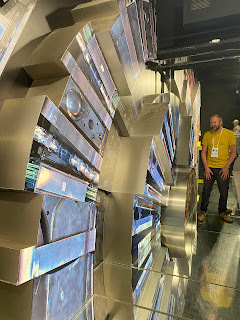 Arty reconstruction of CMS, using mirrors
Arty reconstruction of CMS, using mirrors(cf Maxtible in The Evil of the Daleks)
 Old-skool, pretty wiring in old device
Old-skool, pretty wiring in old device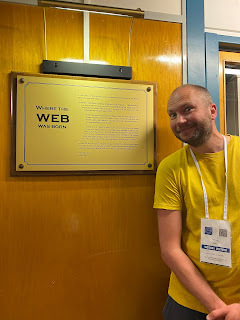 Where the web,
Where the web, and so much of my life, began
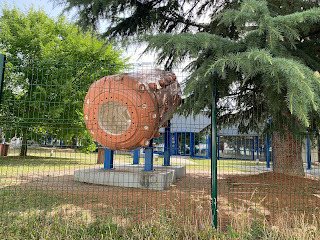 Cool retro tech in a garden
Cool retro tech in a garden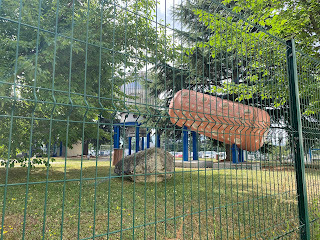 More cool, retro tech
More cool, retro tech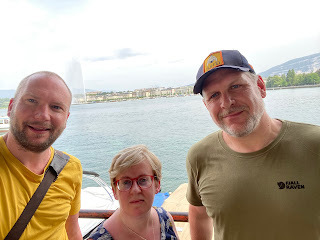 The Champions
The Champions(ie me, Una McCormack and Matthew De Abaitua)
June 17, 2022
Play for Today: The Evolution of Television Drama, by Irene Shubik
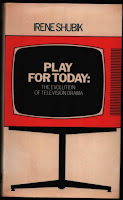
The Wednesday Play was a prestigious anthology of (mostly) one-off plays, 182 of them broadcast by the BBC between 1964 and 1970. The series then moved to a different day of the week and, as Play for Today, a further 306 (mostly) one-off plays were broadcast between 1970 and 1984. One of the producers, Irene Shubik published this memoir in 1975 (and produced a revised, updated edition in 2001), detailing how and why plays were put on.
One reason for writing such a book is to have a permanent record of the plays at all. As Shubik says at the end of the book, the most noteworthy episodes were repeated - but usually just once. There was no facility to buy episodes for home viewer or to see them screened anywhere else. In many cases, episodes weren’t kept by the BBC anyway. The British Film Institute, with a remit to collect and preserve key bits of screen culture, lacked the resources to do much.
“All it [the BFI] can do is send its recommended lists to the BBC in the hope that the programmes will not actually have been wiped or junked. Meanwhile, there is no guarantee that a student in a hundred years time, hoping to make a study of English television productions in the 1970s will have sufficient material to do so; most of these ‘chronicles of our times’ will have vanished into the ether, condemned by the sheer weight of their numbers, to oblivion.” (p. 182)
She provides a long list of all the plays broadcast in the series up to 11 December 1972 - a valuable resource in the days before the internet made such things readily available - and then another, shorter version of those plays that she herself oversaw. She divides these plays into chapters based on type or style, and provides us with her insights - how they were commissioned, anecdotes about production, responses they received from the press and public. There's an engaging mix of gossip and technical detail, just the sort of thing I like.
There is a brief history of television drama prior to 1964: BBC Television began in December 1936; in 1937 some 123 plays were broadcast, an “astonishingly high figure” though many “were repeats and most were very short in length, from 10-30 minutes”. The majority were adaptations from stage and prose works,
“But even in 1937 there were two pieces put out which were original commissions for the medium: The Underground Murder Mystery by J Bissell Thomas (lasting ten minutes) and Turn Round by SE Reynolds lasting thirty minutes. These were the first two pieces of original English TV drama.” (p. 33)
Though there continued to be original works in the years that followed, Shubik marks 1953 as a pivotal moment in television drama.
“The reason why certain names keep recurring from that year [1953] Wilson, Kneale, Philip Mackie, John Elliot, and Anthony Stevens, among them, was that a policy had been adopted of putting certain promising writers on the staff, to form a sort of writer’s workshop. The idea was that by adapting and story-editing other people’s scripts, and working close to the productions, this nucleus of writers could best learn about the medium. Hierarchically, the structure of the department was Head of Drama (Michael Barry) and Head of Script Department (Donald Wilson), with a group of writers and directors working on all types of drama (plays, series and serials) under their supervision. … Nigel Kneale was the first writer to be put on this scheme, in 1951 [having] convinced the BBC drama department to give him a contract (at £5 a week), first to adapt one of is own [prose] stories and later (eventually at £15 a week), to become a staff writer and adapter.” (p. 34)
She remarks on how little this was.
The next pivotal moment in her history is the ITV network ABC (covering the Midlands) making Canadian producer Sydney Newman its head of drama in 1958. Two years later, Newman gave Shubik a job as script editor. In 1963, he began as Head of Drama at the BBC and gave Shubik a job there the following year.
There is a lot of Newman’s character, behaviour and appearance. Shubik quotes fellow story editor Peter Luke’s assessment of Newman as “a cross between Genghis Khan and a pussycat”, refers to his “Groucho-Marx-like sense of humour” and thinks him “undoubtedly one of the most dynamic men who ever worked in English television.” (p. 9). She’s good on why Newman had such an impact, too.
For example, “probably the first controversial piece”, or play, broadcast in the UK under Sydney Newman was Ray Rigby's Boy With a Meat Axe. Shubik quotes from the review by Norman Hare in News Chronicle on 22 November 1958: the play “included a murder accusation, a young girl getting drunk, and a street fight … as well as using a lavatory as one of the settings” (p. 25).
Newman wanted contemporary, revenant drama, yet for all his dramatists tackled the issues of the day, Shubik says Newman also “wanted as much variety as possible on the programme and a few plays starring ‘blondes with big boobs’ to temper the gloom” (p. 19). And while ABC drama anthology series Armchair Theatre did well,
“The size of the audience, as Sydney was always modestly reminding us at script meetings, was undoubtedly helped greatly by the fact that the programme followed [variety show] Sunday Night at the London Palladium” (p. 31)
Given this last point, it’s odd that when Shubik devotes a chapter to audience response, she doesn’t think there’s much to be gained from comparisons across genre. This is her on the merits of knowing numbers of viewers and their percentage score for a given programme (the “appreciation index”):
“Within the framework of his own programme, therefore, the producer can get some idea from programme research as to which plays were most watched and most liked; to compare one’s own programme with other types of programmes, for example comedy or documentary or sport, is a useless occupation as it is accepted that audiences for different types of viewing will differ.” (p. 180)
Newman recognised that this simply wasn’t true: a significant number of those watching a variety show would stay on to watch contemporary drama, even if only because they didn’t make the effort to switch off or over. Likewise, when Newman devised Doctor Who, he wanted a new, made-for-television drama that would retain the audience from sports show Grandstand and appeal to those tuning in for pop music show Juke Box Jury. Achieving this not only made Doctor Who a hit but led to the BBC dominating Saturday evening TV.
There’s no mention of Doctor Who here. Sadly, Shubik tells us that her oversight of anthology series Out of the Unknown (sci-fi) and Thirteen Against Fate (adaptations of stories by Georges Simenon) are not within the purview of this book - a shame, as it would be interested to know how she thought her work on these differed to the more prestigious one-off plays. She briefly mentions her time as story editor on Story Parade, and one episode in particular: an adaptation of Isaac Asimov’s The Caves of Steel (about a detective who is a robot), but doesn’t mention Terry Nation, who adapted it for TV.
What is useful for my research into Doctor Who story editor David Whitaker is the many insights into Sydney Newman: why he broke up the BBC’s drama department (to increase productivity, p. 32); what made him a good producer (“the ability to assess personalities and match talents successfully”, p. 26); what he thought made a good story or script editor (“the courage to tell the author it [a script] was not good enough”, p. 29); what he’d look for when viewing a “producer’s run” of a play in the rehearsal room ( he had a “keen instinct for what was dramatic in a production and what was boring and self-indulgent on the part of the director or actors” and Shubik learned, from him, to “look at an outside rehearsal not as a stage play, but through the eyes of the cameras”, p. 49).
There are other interesting details too - why filming is more expensive than recording on videotape, the practicalities of working with different writers, the buzz of production with limited budget and time. Plus I have another production to add to my list of TV and film made at Grim’s Dyke: an episode of The Wednesday Play by David Rudkin, House of Character, including filming at “Grims Dyke Manor [sic] and Ham House in thick fog” (p. 91), with production beginning in October 1967.
June 15, 2022
Doctor Who Chronicles: 1967
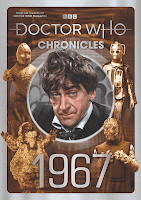 I've a couple of features in the new Doctor Who Chronicles bookazine from the splendid lot that make
Doctor Who Magazine
. This one is devoted to the year 1967.
I've a couple of features in the new Doctor Who Chronicles bookazine from the splendid lot that make
Doctor Who Magazine
. This one is devoted to the year 1967.In "From the Archives", I trawl through BBC paperwork to reveal "the story of a turbulent year and last-minute changes in the making of Doctor Who."
In "Life on Mars", I examine the life of writer Brian Hayles, whose "most enduring contribution to Doctor Who was the creation of the Ice Warriors, but this was just part of his prolific output."
If this is your sort of thing - and why in heaven wouldn't it be? - you can still buy my book on the 1967 Doctor Who story The Evil of the Daleks. And there's also the issue of Doctor Who Chronicles for 1965, in which I wrote some stuff.
Simon Guerrier's Blog
- Simon Guerrier's profile
- 60 followers



